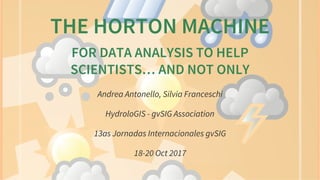
The HortonMachine, for data analysis to help scientists... and not only
- 2. WHO AM I? cofounder of HydroloGIS is member of Charter Member and GFOSS advocate develop and coordinate develop and coordinate the (former JGrasstools) working on integration of the HortonMachine and Geopaparazzi in gvSIG HydroloGIS GvSIG Association Osgeo Geopaparazzi HortonMachine project
- 4. JGRASSTOOLS? HORTONMACHINE? Due to historical reasons and due to the first releases of the gvSIG plugins in the last month the JGrasstools project decided to go back to its original name: The Horton Machine It is beyond the scope of this presentation to discuss further
- 8. HORTONMACHINE MODULES Drainage direction,total contributing area, network and watershed extraction, rescaled distances and hydrologic attributes, slope, curvatures, hydrologic indexes and geomorphologic attributes.
- 9. STATISTICS Interpolation of meteorological data with Kriging (rainfall and temperature) and Jami (temperature, pressure, humidity and wind).
- 10. PEAKFLOW Evaluation of the maximum discharge for a given precipitation (works also with statistical information rainfall Intensity-Duration Curves)
- 14. LESTO Developed in collaboration with the Free University of Bolzano. At the moment the toolbox is mainly dedicated to forestry analysis.
- 17. SINGLE TREE EXTRACTION Vegetation: individual tree crown approaches are followed, aimed to detect position and main characteristics of each single tree. Modules that work both on raster and point clouds.
- 18. THE RASTER MAP CALCULATOR The mapcalc is a tool that can be use to perform map algebra on raster maps. Let’s assume you want to know which part of an elevation model between 1000 and 1300 meters looks towards south. Once you calculated the aspect map with the Spatial Toolbox, you can use a mapalgebra formula like this: if (dtm_all>1000 && dtm_all<1300 && aspect >160 && aspect <200 ) { result = dtm_all; } else { result = -9999.0; }
- 19. THE RASTER MAP CALCULATOR The GUI of the mapcalc looks like the following. And the map from the previous formula like the one in the map view.
- 20. GEOPAPARAZZI TOOLS FOR GVSIG The plugins contain a set of tools dedicated to the interaction with the digital field mapping app for android Geopaparazzi. It is beyond the scope of this presentation to describe these tools. To summarize in gvSIG it is possible to: create the map background data as .mbtile export all the data contained in the project as shapefiles and browse the images linked in the shapefiles
- 21. EPANET EPANET is a powerful and well known software for water supply system management (analysis) and design. Again, it is beyond the scope of this presentation to describe these tools.
- 23. THE POSITION INFO TOOL This tools allows the user to view the clicked coordinates and see them in a different projection and also copies them into the clipboard:
- 24. WKT GEOMETRY TOOL One can select a geometry in the layer and extract the WKT representation of the geometry. The same way one can write/paste some WKT geometry and insert it in the layer.
- 27. THE RASTER STYLER The raster styler can be accessed from the main menu or from the context menu (right click) on raster layers:
- 29. THE RASTER STYLER The map of aspect ranges between 0 and 360 degrees, usually coloured from white to black between 0 and 180, and from black to white between 180 and 360. → 3 rules
- 30. THE RASTER STYLER If we style also an elevation model and add some transparency, we get a nice 3D feeling
- 31. THE RASTER STYLER And then there are maps that need categories. Ex. to nicely read a map of flowdirections you need to have a legend showing the directions.
- 32. RASTER GRAPHICS VIEW We often need to analize small portions of large rasters. Everything looks the same,due to the fact that the colortable is calculated on the whole raster. A local colortable would be handy:
- 33. RASTER GRAPHICS VIEW This is what the Raster Graphics View it here for. Once opened from the context menu of the selected raster, it openes a small window:
- 34. RASTER GRAPHICS VIEW Once selecting the options show cells and no text, it is possible to view the local colortable:
- 38. RASTER VALUES COPY Have you ever needed to analyze small portions of large rasters? And maybe extract those portions to faster investigate them?
- 39. RASTER VALUES COPY Once triggered, it copies the visible portion of the map into the system clipboard as an ascii raster map, ready to be copied into a file and be used:
